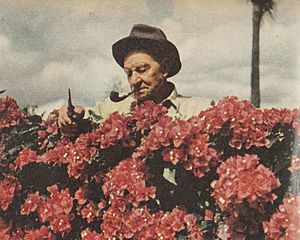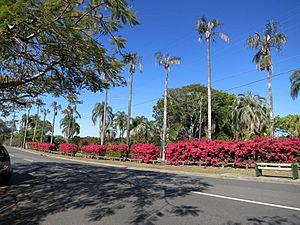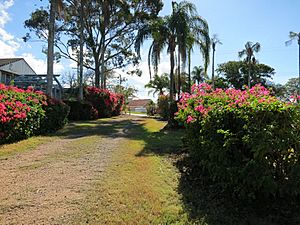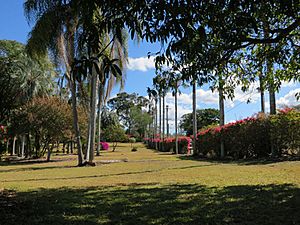Thomas Park Bougainvillea Gardens facts for kids
Quick facts for kids Thomas Park Bougainvillea Gardens |
|
|---|---|
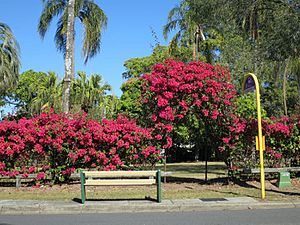
Thomas Park Bougainvillea Gardens, north boundary, 2014
|
|
| Location | 151 Harts Road, Indooroopilly, City of Brisbane, Queensland, Australia |
| Built | 1900 |
| Architect | Henry Thomas |
| Official name: Thomas Park Bougainvillea Gardens; | |
| Type | state heritage |
| Designated | 10 October 2014 |
| Reference no. | 602838 |
| Type | Parks/gardens/trees: Garden-private |
| Theme | Exploiting, utilising and transforming the land: Experimenting, developing technologies and innovation; Exploiting, utilising and transforming the land: Valuing and appreciating the environment and landscapes |
| Lua error in Module:Location_map at line 420: attempt to index field 'wikibase' (a nil value). | |
Thomas Park Bougainvillea Gardens is a special public park in Indooroopilly, Brisbane, Australia. It used to be a private garden owned by Henry Thomas. He designed and built the gardens between 1914 and 1918. This beautiful place was added to the Queensland Heritage Register on October 10, 2014, because of its important history and design.
Contents
The Story of Thomas Park
The Thomas Park Bougainvillea Gardens are located on Harts Road in Indooroopilly, Brisbane. Henry Thomas started creating these large gardens around 1900. For about 40 years, the gardens were a popular place for tourists. People came from all over Australia and even other countries to see the amazing bougainvillea flowers.
Henry Thomas took care of the gardens for almost 60 years. During this time, he grew many new types of bougainvillea plants. These new plants were shown off in his gardens. After 1958, the gardens became a public park. Today, you can still see the original design and many of the plants. It's a great example of a large city garden from the early 1900s.
How the Gardens Began
The area where the gardens are, called Long Pocket in Indooroopilly, was used for farming since the 1860s. A man named Robert Jarrott started an orchard there in 1867. His son continued the farm after Robert passed away. The land was later divided into smaller pieces and sold.
Henry Thomas bought parts of this land between 1898 and 1900. His property was about 3 hectares (7 acres) and was located right by the Brisbane River. He named his home and gardens "Somerset."
Henry Thomas was born in England in 1864. He came to Brisbane in 1883 when he was 19. He worked in different jobs, including as a groom and a coachman. By 1894, when he got married for the second time, he was working as a gardener. From 1897 to 1909, he also ran a stable business in Brisbane.
Growing the Famous Bougainvillea Gardens
Henry Thomas started his gardens around 1900. A newspaper article from 1950 said he planted a purple bougainvillea 49 years earlier. Another article from 1956 mentioned that some large trees, like a tall Norfolk Island pine, a Moreton Bay Fig, and several bottle trees, were planted 60 years before. Pictures from around 1908-1910 show that the gardens already had palms and bougainvillea. Henry Thomas even created a new type of bougainvillea called Bougainvillea spectabilis "Thomasii" before 1905. People started writing about the beauty of the Bougainvillea Gardens in newspapers by 1926.
The Thomas property had a special garden area near the house, which was about one-third of the total land. The rest of the property had fenced areas that went down to the Brisbane River. There was also a large dam on the upper part of the property.
Henry Thomas's house was in the middle of the western part of the garden. The gardens were designed in a formal way. Bougainvillea hedges marked the edges and different sections, like the drying area, tennis court, and vegetable garden. Crushed gravel paths and driveways led from Harts Road to the house. The main driveway went to the house and ended in a circle around a palm tree with a staghorn fern.
The front of the property on Harts Road had a fence. First, it was a picket fence around 1912, and later it was a painted timber and wire fence around 1935.
The Bougainvillea Gardens had many evergreen trees like palms, fig trees, mango trees, and bottle trees. The main color came from the bougainvillea, including the type Henry Thomas created. Other colorful plants like crotons, orange crucifix orchids, and poinsettias also added to the beauty. There were also annual flowers planted in garden beds near the main path.
Archways covered in bougainvillea stood at the main entrances for cars and people. A pergola also covered the path near the pedestrian entry. More pergolas and arches with bougainvillea were along the west side of the house. Steel trellises held up bougainvillea in front of the north side of the house. Large urns were placed at the bottom of the steps to the house.
A Popular Tourist Spot
From the 1920s until at least 1958, Henry Thomas's Bougainvillea Gardens were a very popular place. Locals and visitors from all over Australia and other countries came to see them. Many garden parties were held there to raise money for good causes.
In 1926, the gardens were already known as a "sight of Brisbane." Important visitors from other states were taken there to see the "wonderful bougainvillea hedges." In 1927, money raised from visitors was given to the Children's Hospital Fund. The first big garden party was in 1929 for St Andrew's Church of England. This event happened every year until at least 1939, bringing hundreds of people to the gardens. One party in 1933 raised money for St John's Cathedral and attracted almost 3000 people!
By 1940, the Queensland Government Tourist Bureau offered regular trips to the gardens during the winter tourist season. Many important people visited, including politicians, artists like Margaret Preston, and even the wife of Prime Minister John Curtin, Elsie Curtin.
The gardens were featured in newspapers, magazines, and books across Australia. Color pictures appeared in The Queenslander and The Australian Women's Weekly. Cinesound even made a newsreel about the gardens in 1937. Photos of the gardens were used in books and calendars, showing how famous they were.
Henry Thomas became very well-known in Brisbane because of his gardens and the new bougainvillea types he created. The media called him "Mr Bougainvillea" and "the Bougainvillea King." His most famous type, Bougainvillea spectabilis "Thomasii", was sent all over Queensland and even overseas. People said, "the variety Thomasii is too well known to need description."
Thomas's Bougainvillea Gardens also inspired other gardens in Brisbane and beyond. Newspapers reported that B. "Thomasii" was growing in other gardens and even used for road beautification. Nurseries sold cuttings from his garden. Photos and stories about the gardens encouraged many people to grow bougainvillea.
Becoming a Public Park
After World War II, the Brisbane City Council (BCC) wanted to buy the Bougainvillea Gardens to make it a public park. Henry Thomas agreed in 1947, as long as it would be for public use and he could stay there as a caretaker. He also offered to help plan how to make the park even more beautiful. The Council agreed, saying the property was "acquired for park purposes for the use and enjoyment of the citizens of Brisbane and visitors." A newspaper at the time called it a "world-wide reputation as a beauty spot."
Even after the Council bought it, the gardens continued to host fundraising events and daily afternoon teas. Visitors were given cuttings from the plants to grow their own bougainvillea.
Henry Thomas passed away in April 1958. After his death, the Council's landscape architect, A. E. Wilson, leased the property. He had to make sure the gardens were open to visitors for free on weekends and holidays.
By 1962, the Council had new plans for the land, including the gardens. They wanted to create the Sir John Chandler Park. The Council invited bids to develop parts of the park for golf and other sports. The Indooroopilly Golf Club (IGC) made an offer. In 1962, the Council agreed to lease a large area, including the Bougainvillea Gardens, to the IGC for 10 years. The golf club was supposed to use Henry Thomas's house as a clubhouse and maintain the gardens.
The Indooroopilly Golf Club's new course opened in March 1964. However, the club did not use Henry Thomas's house for long. By October 1964, the house was torn down because it was old and vandals were getting into it. The Council said it would be too expensive to fix.
In 1965, the IGC wanted to lease more land from the lower part of the Bougainvillea Gardens to expand its golf course. The Council agreed, but only if the IGC built two sports fields for public use. The IGC agreed, and in 1967, the Council extended the lease to include the Bougainvillea Gardens. The IGC had to maintain the gardens and allow public access from 10 am to 4 pm daily, making sure the golf course was safe.
The IGC then started building its new 9th golf hole on the lower part of the gardens. They even filled in the garden's dam. The club took over maintaining the Bougainvillea Gardens from January 1968.
Later, in 1977, a new lease was made for the land used by the IGC. From 1980, some of Henry Thomas's family complained to the Council. They said the gardens were not being maintained and that the land was not fully used for public purposes, as part of it was a golf course.
At some point, the responsibility for maintaining the Bougainvillea Gardens went back to the Brisbane City Council Parks Department. They still take care of it today.
What Remains Today
Many studies have looked at how well the Bougainvillea Gardens have been kept. A study in 2002 found that the garden was in good condition. Much of the original design and plants were still there. A 2008 plan also found that many original parts of the garden, including plants from Henry Thomas's time, were in good shape. A plant survey in 2014 confirmed this, noting that only a few trees had died or been removed.
In 2014, the original B. spectabilis "Thomasii" plant and many other bougainvillea plants, along with mature trees and palms, were still in the park. You can still easily see the layout of Henry Thomas's garden by looking at a 1958 map. An old archway at the pedestrian entry and an early telegraph pole in the northwest corner are also still there.
Some things have been removed from the garden, like the house and other buildings, the old fences, pergolas, and most archways. The gravel driveways and paths are now hidden. Some plants have been removed or died and were not replaced. The golf club also changed the boundary of the park when they extended a golf fairway. This change cut off the garden from the Brisbane River, which it used to have access to and views of.
New things added to the park include benches, picnic tables, a water bubbler, and a bin. Some new plants have also grown or been added.
Even though it's now a park, Thomas Park Bougainvillea Gardens still has enough of its original layout and plants to be recognized as a special garden. It is like a large city garden from the early 1900s, with features also found in suburban and homestead gardens. These include its large size, beautiful front gardens, and useful back gardens. Like other large gardens, it had a carriage-way with a turning circle. It also had tree-lined paths, a service area, and was on high ground with views and close to water. It had a vegetable garden, which was often fenced off.
Gardens from the early 1900s often had special architectural parts. Fences were usually painted timber. Entrances for people and for service vehicles were common, with special plants or gates at the visitor's entry. Lattice work, pergolas, gazebos, and rose arches were also popular. Greenhouses and fern houses were often made of timber. These gardens often had evergreen trees and colorful flowers.
Thomas Park Bougainvillea Gardens fits the "Geometric Federation style" of gardens. This style includes:
- Fences, hedges, or vine-covered walls around the garden.
- The garden divided into square or rectangle areas near the house using trellises, fences, walls, pergolas, and hedges.
- Special areas like a pleasure garden, a kitchen garden, a drying garden, an orchard, and a tennis court.
- Features like lawns, small trees, shrubs, hedges, and flower beds.
- A very neat and tidy look.
Why the Gardens are Important
Many studies have shown how important Thomas Park Bougainvillea Gardens are. A 1996 study called it an "important example of a private garden that has inspired or still inspires Queensland gardeners." Other important gardens mentioned in this study are also listed on the Queensland Heritage Register.
In 2002, a book called The Oxford Companion to Australian Gardens also recognized the gardens' importance. It said that "Somerset" or Bougainvillea Gardens was a favorite tourist spot in the 1920s and 1930s, especially when the bougainvillea was blooming. Henry Thomas experimented with plants and created the strong, pink Bougainvillea spectabilis "Thomasii". His gardens had special Queensland plants, including palms, shade trees, tropical plants (with 15 types of bougainvillea!), and a 25-meter (82 ft) timber trellis covered in B. "Thomasii".
The gardens were also featured in the Australian Garden History Society Journal. In 2013, a report by the Australian Garden History Society included Thomas Park Bougainvillea Gardens as a place of state importance.
What You Can See Today
Thomas Park Bougainvillea Gardens is a public park that covers about 1.21 hectares (3 acres) on the south side of Harts Road, Indooroopilly. The park has two main parts: the northern garden, which still has parts of the old "Somerset" residence and its plants, and the southern grassy slope that goes down towards the Brisbane River. The park is next to private homes on the west and the Indoorooroopilly Golf Course on the east. You can get great views of the golf course and the river from certain spots in the park.
The most striking thing about Thomas Park is its many mature bougainvillea plants. They are planted in different ways, like single shrubs, long hedges, or climbing over fences and trees. Most of the bougainvillea are the reddish-pink, very flowery "Thomasii" type. There's a very large "parent plant" of this type near where the old house used to be. These bougainvillea also form long hedges that mark the old garden boundaries. You can also find red, purple, deep pink, white, and pink-and-white bougainvillea in the park.
The northern garden area is a gently sloping, triangle-shaped piece of land at the highest point of the park. You can still see much of the original garden design. There are parts of the decorative garden that faced Harts Road and service gardens at the back. Straight lines of two old driveways, a former walking path, long hedges, and rows of mature trees separate different parts of the garden. These lines divide the public ornamental gardens from the private service areas, which included a drying area, a tennis court, and a vegetable garden. You can also see the flat, open areas where the house and stables used to be, surrounded by old plants. Several large, old trees are important parts of the garden's design. The southern grassy slope is an open area with trees around its edges, dropping steeply down towards the southern tip of the park.
The edge of the park along Harts Road is marked by large reddish-pink bougainvillea hedges and tall, evenly spaced Cocos Palms. Even with some gaps, this planting still looks impressive. A metal archway, made of narrow metal poles, stands at the original entrance for people. The bougainvillea on each side is trained to grow over it.
The western edge of the park, next to homes, has many mature trees. At the northern end, there are large bougainvillea hedges and Cocos palms. Further south, there's a very large Weeping Fig tree. Other old trees along this boundary include Poinciana, Mango, Jacaranda, Small-leaved Fig, and Queensland Kauri.
The south-east edge of the park generally follows the edge of the higher ground before sloping steeply down. Many bougainvillea and mature trees are planted along this edge, including an English Oak, a Bribie Island Pine, Cocos Palms, and a large Bunya Pine. The north-east corner of the southern grassy area also has several tall, individual bougainvillea and a large Womans Tongue Tree.
The old ornamental garden is a triangle-shaped lawn area. It's bordered on its south side by the old main driveway and where the house used to be, and on its west side by an old service driveway. The main driveway starts at the east end of Harts Road and goes west to what was once a turning circle in front of the house. The service driveway starts at the west end of Harts Road and goes south to where the stables used to be. Both driveways still show signs of their crushed gravel surface. The main driveway has a clear raised area. It's lined on both sides by rows of palms, including Date, Dwarf Date, Wine, and Cocos palms. The turning circle still has a single palm in the center and traces of gravel. A new timber archway over the old main driveway supports an original reddish-pink bougainvillea plant. The service driveway is bordered by bougainvillea hedges on its east side. An old metal telegraph pole is also along this driveway.
Running north-south through the middle of the ornamental garden is a line of trees that matches the front archway. This marks where an old walking path used to be. This line of trees includes Cabbage Palms and Date Palms. To the west of the path is a mulched area and two Cocos palm trees, showing where an old circular garden bed was. To the east, a purple-pink bougainvillea shrub and a guava tree are all that remain of a large, wedge-shaped garden bed. A Bribie Island Pine is also in this area.
The old house site in the southwest corner of the garden is a flat lawn area, about 25 meters (82 ft) long and 17 meters (56 ft) wide. You can still see old concrete slabs covered in grass, marking things like the bottom of steps that led to the old verandah. The large "Thomasii" bougainvillea parent plant that once covered the verandah still stands on the north side of this area. It has long, thick branches spreading out, supported by modern timber frames. A bit further north, a row of old trees, including alternating Mango and Cocos Palm trees, runs parallel to the "Thomasii" bougainvillea.
The old stables site, southwest of the house site, is a flat grassy area surrounded by plants. To the east is the old drying area, bordered by shrubs and trees (including a bauhinia) on the west side and a long bougainvillea hedge on the south side. Two large Queensland Bottle Trees mark the north edge of this area. A very large Fig tree marks the boundary between the old drying area and the old tennis court to the east.
The old tennis court and vegetable garden are in the southeast corner of the garden. Now, they are one open, long, flat grassy area. A thick bougainvillea hedge borders the northern edge. You can still see parts of an old fence, like weathered timber posts and barbed wire, tangled in this hedge. The southeast corner of the old vegetable garden has been cut off by the eastern boundary fence.
Why Thomas Park Bougainvillea Gardens is Heritage Listed
Thomas Park Bougainvillea Gardens was added to the Queensland Heritage Register on October 10, 2014. This means it is considered very important to Queensland's history and culture for several reasons:
Showing Queensland's History
The Thomas Park Bougainvillea Gardens, started around 1900, are important because they show how garden design and planting changed in Queensland in the early to mid-1900s. They focused on showing off different types of bougainvillea among other special Queensland plants like palms and shade trees. This helped make bougainvillea a very popular plant in gardens across tropical and subtropical Queensland.
The gardens are also important because they were a place where new types of bougainvillea were created in the early 1900s. The original plant of the most famous type, B. spectabilis 'Thomasii', still grows in the park today.
Showing Garden Design
The Thomas Park Bougainvillea Gardens are a great example of a large city garden designed in the "geometric Federation style."
This style has certain features:
- The garden is enclosed by hedges.
- It's divided into square or rectangle areas near the house using hedges.
- It has special areas like a pleasure garden, a kitchen garden, and a drying garden.
- It includes lawns, small trees and shrubs, hedges, and gravel paths.
- It features evergreen trees and colorful shrubs.
- It has separate entrances for people and for service vehicles, with special plants at the visitor's entrance.
- It shows a focus on plant breeding, especially with bougainvillea.
The Thomas Park Bougainvillea Gardens are still very complete and well-preserved, showing how special the original gardens were.
Its Beautiful Appearance
The Thomas Park Bougainvillea Gardens are important for their beauty. They still have their original layout, old trees, and the bougainvillea plants that made them a tourist attraction from about 1920 to 1960. They show the beautiful qualities of a well-designed formal garden. This garden uses one main type of plant, the bougainvillea, to connect all its different parts, like symmetrical rows of trees and enclosing hedges. For many years, these gardens were photographed, filmed, and written about, attracting visitors from Australia and around the world.
Connection to the Community
The Thomas Park Bougainvillea Gardens had a special connection with the wider Queensland community. From the 1920s to the 1960s, they were known as a beautiful place, as shown by many newspaper and magazine articles and widely published pictures.
Connection to Henry Thomas
Thomas Park Bougainvillea Gardens has a special link to Henry Thomas. He was a famous person in Queensland from the 1920s to the 1950s because he created these gardens and many new types of bougainvillea. He designed and planted the garden around 1900. He also created the B. spectabilis 'Thomasii' bougainvillea, which was named after him, and the original plant still grows in the park.
For almost 60 years, Thomas Park Bougainvillea Gardens was Henry Thomas's home. It was where he did his plant work, and it was known as an important tourist spot during his lifetime.
Images for kids
See also
- Parks and gardens of Brisbane


